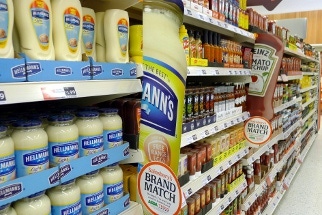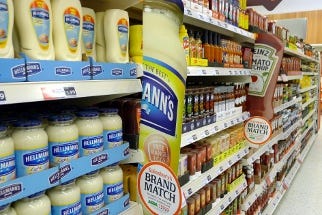

Sainsburys shelf
Packaging experts across the consumer packaged goods industry are rapidly trying to get up to speed on the concept of retail-ready packaging (RRP) and what it means for their business. RRP began appearing in western Europe about a decade ago, where it is commonly used by retailers and continues to evolve.
Over the last five years or so, European-based retailers have "exported" the concept of RRP to other regions of the globe, including Australia and parts of Asia and South America. Most recently, a handful of retailers in Canada and the U.S. have started to slowly implement RRP solutions on their shelves.
Two key challenges, however, face the consumer packaged goods industry in North America as RRP solutions are implemented. The first challenge is that RRP lacks industry standards. While retailers and suppliers around the globe are aligned on the "5 Easies"—Easy to Identify, Open, Stock, Shop and Dispose—the details and requirements of how to implement each "Easy" standard vary from retailer to retailer and will make it difficult for suppliers to deliver solutions with broad application. Gaining broad consensus will be challenging and may require facilitation by industry groups such as the U.S. Grocery Manufacturers Assn. (GMA) and the Food & Consumer Products of Canada (FCPC).
The second challenge is RRP's business model. In general, implementing RRP incurs additional supply chain costs for suppliers while retailers gain store labor savings and efficiencies. There may be joint benefits in terms of improved on-shelf availability and shopper acceptance, but there is little data from Europe or elsewhere to support these potential joint benefits. Collaborative testing involving both retailers and suppliers will likely be the key to quantifying the true benefits and costs of RRP.
As RRP slowly emerges in North America, some recent articles in the industry suggest that we should simply adopt the European model and implement it quickly despite the key challenges. While in some cases it can be beneficial to apply lessons learned elsewhere, implementing RRP in Canada and the U.S. won't be as easy as simply adopting a European approach. In many European countries, Australia and Canada, the majority of the market share lies with two to five major retailers, while in the U.S., there are about 15 retailers making up a similar market share. While two retailers in Canada support RRP and make up a "critical mass," only a handful of retailers in the U.S. currently support it.
This article outlines six myths and corresponding lessons learned from Europe that I believe the North American consumer packaged goods industry should keep in mind as we consider widespread implementation of RRP over the coming years.
Myth #1: All European retailers are using RRP everywhere in the store.
The lesson learned here is that RRP use in Europe, even after a decade, varies widely from country to country, and within a country, varies from retailer to retailer and from category to category. Western Europe is generally considered to be the furthest along in terms of RRP implementation, yet the variation is readily apparent on the shelves. One large German retailer, like some major U.S. retailers, has a "clean shelf policy" and doesn't want its shoppers to see RRP solutions on the shelf. Several large retailers in the U.K. have some categories, such as pasta and flour, where there are few RRP solutions on the shelf. Other retailers, such as some in Spain, use RRP solutions in some categories, but not in others even when those solutions are readily available. RRP is almost nonexistent in the frozen food categories because of design challenges posed by widely varying equipment types and dimensions, as well as concerns about increased utility costs and maintaining temperatures with lots of corrugated material in freezers. A market visit in Western Europe easily uncovers the wide variation in RRP adoption and use.
Myth #2: European retailers helped RRP implementation by aligning on basic requirements.
In reality, there was, and continues to be, little in the way of broad alignment on basic RRP requirements such as shelf depth and use of whiteboard vs kraft and general packaging types. In the U.K., for example, there are five major retailers and their shelf depths vary considerably. According to an ECR-U.K. report titled Shelf Sizes Standardisation, there is variation not only from retailer to retailer, but often within a retailer from category to category. While Sainsbury has uniform shelf depths, Asda's vary from 22.4 to 30.3 inches. Shelf depths in the cereal category vary widely: 22.4, 23.6, 25 and 30.3 inches. The inability to gain alignment on one of the most basic RRP requirements will pose a serious design challenge for packaging R&D engineers, especially since those RRP designs will need to fit our standard 40x48-inch pallet.
Myth #3: After a decade of implementation, European RRP is optimized.
While there are some great solutions that embody all five "Easies," RRP is still a work in progress. Some categories, such as confectionery, are well-developed with solutions that are "Easy to Identify" in the backroom, "Easy to Open" by store associates, "Easy to Stock" quickly in one movement, "Easy to Shop" for shoppers and "Easy to Dispose" of when empty. However, one can find many average, and even poor, examples of RRP during a walk through the stores of several European retailers. There are RRP offerings in many aisles of the store that can benefit from another round of improvement—from a case of cheese slices falling apart on the shelf, to a tray with a front lip covering most of the product to an RRP case that leaves no room on the shelf for a shopper to easily remove a carton.
Myth #4: Europe implemented RRP without incurring additional costs.
This belief is only partially true. A decade ago, there was likely more opportunity for implementing changes on inefficient packaging solutions and maintaining costs (or even saving some money). For example, Old El Paso-branded Mexican salsa items in western Europe used to be in a robust corrugated regular-slotted container (RSC) with internal dividers protecting the glass jars. When retailers asked for an RRP solution on those items, the business team changed the packaging to a tray-and-shrink wrap format with colorful branding. While this format was less expensive and resulted in a better solution for the supplier, retailer and shopper, it's also important to note that it required an investment in new packaging equipment. In North America, especially after the last five years of cost volatility, some RRP cost savings opportunities may still remain, but probably not like some European businesses a decade ago.
Myth #5: All shoppers like RRP.
There is little data to suggest that European retailers and suppliers did any testing with shoppers prior to, or during, RRP implementation. The potential benefit to shoppers is that, when well-executed, RRP can improve the organization and appearance of the shelf and make it "Easy to Shop." Perhaps the products that shoppers want to purchase are in-stock more often. The potential turn off for shoppers is that they now see all of the corrugated material that used to disappear when store associates stocked the shelves on the off shift, and with the importance of environmental sustainability to many shoppers, "new" corrugated packaging appearing on the shelf may cause some shoppers to have a negative perception of suppliers and retailers. Also, shoppers will likely also have to deal with the hassle of empty RRP packaging on the shelf and some poorly-designed RRP.
Myth #6: RRP solutions designed for European supply chains can be used in North America.
Supply chains in Europe and North America differ in some aspects. While stacking pallets is common in many supplier and some retailer distribution centers, racking is more frequently used in Europe. A frequently used "Easy to Open" feature for RRP solutions is perforations, which can weaken the compression strength of corrugated cases by from 5 to 30 percent depending on the specific design. Given the longer geographical distances that products generally travel in North America vs Europe, our RRP solutions will likely need to be more robust to ensure products remain undamaged from supplier to shelf. RRP solutions won't work if they deliver in-store efficiencies, but fail to protect the product and cause an increase in costly unsaleables because of damage. Before adopting an RRP solution that looks great on the shelf in London, U.K., significant development and testing will be needed to ensure a similar design will work in London, TX.
Weigh costs vs benefits
In summary, there are some important lessons from Europe's decade of RRP experience that our industry should evaluate as we consider broad implementation of RRP in North America. Success will require strong collaboration and partnership among not only suppliers and retailers, but also corrugated vendors. We should test potential RRP solutions and determine the true benefits and costs of the approach specifically for North America, from joint supply chains to store shelves to shopper interactions. Industry groups such as the GMA and FCPC could play an important role in facilitating RRP standards and basic requirements. "Evolution, not Revolution" is likely the best approach to RRP for North America.
Tom Hammann, senior manager at General Mills, works in supply chain strategic initiatives, with a focus on holistic margin management, customer supply chains and operations. His responsibilities include packaging initiatives, such as retail-ready packaging for North American markets.
.
About the Author(s)
You May Also Like


